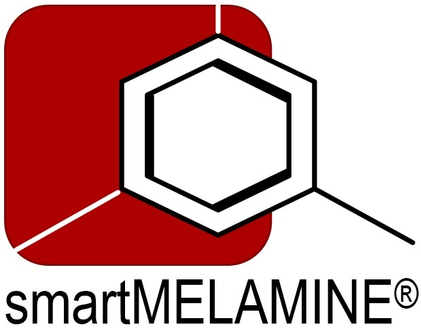|
SAFETY DATA SHEET according to Regulation 1907/2006 amended by 2020/878/EU
Product name: smartMELAMINE
Creation date: 29.7.2016 ·
Revision: 19.2.2021 ·
Version: 2.2
|
 |
1. Identification of the substance/mixture and of the company/undertaking

chemius.net/dHlc6
1.1. Product identifier
Product name
smartMELAMINE
1.2. Relevant identified uses of the substance or mixture and uses advised against
Relevant identified uses
Industrial use
Uses advised against
There are no uses advised against.
1.3. Details of the supplier of the safety data sheet
Supplier
smartMELAMINE d.o.o.
Address: Tomšičeva 9, SI-133 Kočevje, Slovenia
Phone: +49 3672 379 130
Fax: +49 3672 379 379
E-mail: info@smartMELAMINE.com
| |
1.4. Emergency telephone number
112
2. Hazards identification
2.1 Classification of the substance or mixture
Classification according to Regulation (EC) No 1272/2008 (CLP)
According to the regulation, the product is not classified as hazardous.
2.2 Label elements
2.2.1. Labelling according to Regulation (EC) No 1272/2008 [CLP]
Pictograms not applicable according to Regulation 1272/2008.
2.2.3. Special provisions
Persons with a history of skin sensitisation problems or asthma, allergies or chronic or recurrent respiratory disease should not be employed in any process in which this product is used.
2.3. Other hazards
No information.
3. Composition/information on ingredients
Product description
Polymer based on melamine resin.
3.1. Substances
For mixtures see 3.2.
3.2. Mixtures
| Name |
CAS
EC
Index |
% |
Classification according to Regulation (EC)
No 1272/2008 (CLP) |
Specific Conc. Limits |
Classification according to directive 67/548/EEC or 99/45/EC |
REACH Registration No. |
| Melamine-formaldehyde resin |
9003-08-1
-
- |
>99,99 |
not classified |
|
not classified |
- |
| formaldehyde [B, D] |
50-00-0
200-001-8
605-001-00-5 |
<0,01 |
Acute Tox. 3; H301
Acute Tox. 3; H311
Skin Corr. 1B; H314
Skin Sens. 1; H317
Acute Tox. 3; H331
Muta. 2; H341
Carc. 1B; H350 |
Skin Corr. 1B; H314: C ≥ 25 %
Skin Irrit. 2; H315: 5 % ≤ C < 25 %
Skin Sens. 1; H317: C ≥ 0,2 %
Eye Irrit. 2; H319: 5 % ≤ C < 25 %
STOT SE 3; H335: C ≥ 5 % |
T; R23/24/25
C; R34
Carc. Cat. 2; R45
Muta. Cat. 3; R68
Xi; R43 |
- |
Notes for substances:
| B |
Some substances (acids, bases, etc.) are placed on the market in aqueous solutions at various concentrations and, therefore, these solutions require different classification and labelling since the hazards vary at different concentrations.
In Part 3 entries with Note B have a general designation of the following type: "nitric acid … %".
In this case the supplier must state the percentage concentration of the solution on the label. Unless otherwise stated, it is assumed that the percentage concentration is calculated on a weight/weight basis. |
| D |
Certain substances which are susceptible to spontaneous polymerisation or decomposition are generally placed on the market in a stabilised form. It is in this form that they are listed in Part 3.
However, such substances are sometimes placed on the market in a non-stabilised form. In this case, the supplier must state on the label the name of the substance followed by the words "non-stabilised". |
4. First aid measures
4.1. Description of first aid measures
General notes
When in doubt or if feeling unwell seek medical assistance.
Following inhalation
No special measures required.
Following skin contact
No special measures required.
Following eye contact
No special measures required.
Following ingestion
No special measures required..
4.2. Most important symptoms and effects, both acute and delayed
Inhalation
No symptoms are expected.
Skin contact
No symptoms are expected.
Eye contact
No symptoms are expected.
Ingestion
No symptoms are expected.
4.3. Indication of any immediate medical attention and special treatment needed
There is no specific antidote.
5. Firefighting measures
5.1. Extinguishing media
Suitable extinguishing media
This material will not burn readily. Carbon dioxide. Dry chemical powder. Water spray. Alcohol resistant foam.
Unsuitable extinguishing media
-
5.2. Special hazards arising from the substance or mixture
Hazardous combustion products
In case of a fire toxic gases can be generated; do not inhale gases/smoke.
5.3. Advice for firefighters
Protective actions
-
Special protective equipment for firefighters
Full protective clothing and self-contained breathing apparatus.
6. ACCIDENTAL RELEASE MEASURES
6.1. Personal precautions, protective equipment and emergency procedures
6.1.1. For non-emergency personnel
Protective equipment
-
Emergency procedures
Avoid dust formation.
6.1.2. For emergency responders
-
6.2. Environmental precautions
-
6.3. Methods and material for containment and cleaning up
6.3.1. For containment
-
6.3.2. For cleaning up
Pick up mechanically and remove it in accordance with regulation. Collect with suitable tools (shovel,...)
6.3.3. Other information
-
6.4. Reference to other sections
See also Sections 8 and 13.
7. Handling and storage
7.1. Precautions for safe handling
7.1.1. Protective measures
Measures to prevent fire
Special safety precautions are not necessary; handle according to work instructions.
Measures to prevent aerosol and dust generation
Avoid formation of dust. Ensure adequate ventilation.
Measures to protect the environment
-
7.1.2. Advice on general occupational hygiene
Do not breathe dust. Do not eat, drink or smoke while working.
7.2. Conditions for safe storage, including any incompatibilities
7.2.1. Technical measures and storage conditions
It has unlimited shelf life by normal storage condition.
7.2.2. Packaging materials
-
7.2.3. Requirements for storage rooms and vessels
-
7.2.4. Storage class
Storage class: 13
7.2.5. Further information on storage conditions
-
7.3. Specific end use(s)
Recommendations
-
Industrial sector specific solutions
-
8. Exposure controls/personal protection
8.1. Control parameters
8.1.1. Occupational exposure limit values
8.1.2. Information on monitoring procedures
BS EN 14042:2003 Title Identifier: Workplace atmospheres. Guide for the application and use of procedures for the assessment of exposure to chemical and biological agents. BS EN 482:2021 Workplace exposure. Procedures for the determination of the concentration of chemical agents. Basic performance requirements.
8.1.3. DNEL/DMEL values
For components
| Name |
Type |
Exposure route |
Exposure frequency |
Value |
Remark |
| formaldehyde (50-00-0) |
Worker |
inhalation |
long term (systemic effects) |
9 mg/m3 |
|
| formaldehyde (50-00-0) |
Worker |
inhalation |
long term (local effects) |
0,5 mg/m3 |
|
| formaldehyde (50-00-0) |
Worker |
inhalation |
short term (local effects) |
1 mg/m3 |
|
| formaldehyde (50-00-0) |
Worker |
dermal |
long term (local effects) |
0,037 mg/cm2 |
|
| formaldehyde (50-00-0) |
Worker |
dermal |
long term (systemic effects) |
240 mg/kg bw/day |
|
| formaldehyde (50-00-0) |
Consumer |
oral |
long term (systemic effects) |
4,1 mg/kg bw/day |
|
| formaldehyde (50-00-0) |
Consumer |
dermal |
long term (systemic effects) |
102 mg/kg bw/day |
|
| formaldehyde (50-00-0) |
Consumer |
dermal |
long term (local effects) |
0,012 mg/cm2 |
|
| formaldehyde (50-00-0) |
Consumer |
inhalation |
long term (systemic effects) |
3,2 mg/m3 |
|
| formaldehyde (50-00-0) |
Consumer |
inhalation |
long term (local effects) |
0,1 mg/m3 |
|
8.1.4. PNEC values
For components
| Name |
Exposure route |
Value |
Remark |
| formaldehyde (50-00-0) |
fresh water |
0,47 mg/L |
|
| formaldehyde (50-00-0) |
marine water |
0,47 mg/L |
|
| formaldehyde (50-00-0) |
water, intermittent release |
4,7 mg/L |
|
| formaldehyde (50-00-0) |
water treatment plant |
0,19 mg/L |
|
| formaldehyde (50-00-0) |
fresh water sediment |
2,44 mg/kg |
|
| formaldehyde (50-00-0) |
marine water sediment |
2,44 mg/kg |
|
| formaldehyde (50-00-0) |
soil |
0,21 mg/kg |
|
8.2. Exposure controls
8.2.1. Appropriate engineering control
Substance/mixture related measures to prevent exposure during identified uses
Prevent dusting. Do not eat, drink or smoke while working.
8.2.2. Personal protective equipment
Eye and face protection
If there is a risk of eye contact use safety glasses.
Hand protection
Choose protective gloves in accordance with workplace specifics. Observe the manufacturer's instructions regarding the use, storage, maintenance and replacement of gloves. In case of damage or at the first signs of wear and tear, change the gloves immediately.
Skin protection
Working clothes and shoes.
Respiratory protection
Not needed under normal use and adequate ventilation.
8.2.3. Environmental exposure controls
-
9. PHYSICAL AND CHEMICAL PROPERTIES
9.1. Information on basic physical and chemical properties
| - |
Physical state: |
solid |
| - |
Colour: |
according to specification |
| - |
Odour: |
no odour |
Important health, safety and environmental information
| - |
pH |
Not applicable |
| - |
Melting point/freezing point |
not relevant |
| - |
Initial boiling point/boiling range |
Not relevant |
| - |
Flash point |
Not relevant |
| - |
Evaporation rate |
Not relevant |
| - |
Flammability (solid, gas) |
Not relevant |
| - |
Explosion limits (vol%) |
Not relevant |
| - |
Vapour pressure |
Not relevant |
| - |
Vapour density |
Not relevant |
| - |
Density |
Density:
10 – 50 kg/m3 |
| - |
Solubility |
Water:
Insoluble |
| - |
Partition coefficient |
No information. |
| - |
Auto-ignition temperature |
Not relevant |
| - |
Decomposition temperature |
> 350 °C |
| - |
Viscosity |
Dynamic:
not applicable |
| - |
Explosive properties |
Product is not explosive. Product is not self igniting. |
| - |
Oxidising properties |
Not oxidising. |
| - |
Particle characteristics |
No information. |
9.2. Other information
| - |
Solid contents |
100 % |
| - |
Remarks: |
|
10. STABILITY AND REACTIVITY
10.1. Reactivity
No dangerous reaction known under conditions of normal use.
10.2. Chemical stability
Stable at normal contidions.
10.3. Possibility of hazardous reactions
There are no known hazardous reactions.
10.4. Conditions to avoid
-
10.5. Incompatible materials
Strong oxidising agents. Strong acids.
10.6. Hazardous decomposition products
Under normal use conditions no hazardous decomposition products are expected. Hazardous decomposition products could be formed by thermal decomposition.
11. Toxicological information
11.1. Information on hazard classes as defined in Regulation (EC) No 1272/2008
(a) Acute toxicity
| Additional information: The product is not classified for acute toxicity. |
(b) Skin corrosion/irritation
| Additional information: The product is not classified as irritating to skin and eyes. |
(c) Serious eye damage/irritation
No information.
(d) Respiratory or skin sensitisation
| Additional information: The product is not classified as sensitising. The possibility of extremely sensitive persons developing allergic reactions can not be excluded. |
(e) (Germ cell) mutagenicity
| Name | Type | Species | Time | Result | Method | Remark |
|---|
| For product | | | | | Based to our knowledge and experience there are no adverse health effects expected if handled as recommended. | |
(f) Carcinogenicity
| Name | Exposure route | Type | Species | Time | Value | Result | Method | Remark |
|---|
| For product | | | | | | Based to our knowledge and experience there are no adverse health effects expected if handled as recommended. | | |
(g) Reproductive toxicity
No information.
Summary of evaluation of the CMR properties
The product is not classified as carcinogenic, mutagenic or toxic for reproduction.
(h) STOT-single exposure
No information.
(i) STOT-repeated exposure
| Name | Exposure route | Type | Species | Time | Organ | Value | Result | Method | Remark |
|---|
| For product | - | - | | | | | Based to our knowledge and experience there are no adverse health effects expected if handled as recommended. | | |
(j) Aspiration hazard
No information.
11.2. Information on other hazards
11.2.1. Endocrine disrupting properties
No information.
11.2.2. Other information
No information.
12. Ecological information
12.1. Toxicity
12.1.1. Acute (short-term) toxicity
No information.
12.1.2. Chronic (long-term) toxicity
No information.
12.2. Persistence and degradability
12.2.1. Abiotic degradation, physical- and photo-chemical elimination
No information.
12.2.2. Biodegradation
No information.
Additional information
Not easily biodegradable.
12.3. Bioaccumulative potential
12.3.1. Partition coefficient
No information.
12.3.2. Bioconcentration factor (BCF)
No information.
Additional information
No bioaccumulation expected.
12.4. Mobility in soil
12.4.1. Known or predicted distribution to environmental compartments
No information.
12.4.2. Surface tension
No information.
12.4.3. Adsorption/Desorption
No information.
Additional information
Absorption to soil is not expected.
12.5. Results of PBT and vPvB assessment
The components in this formulation do not meet the criteria for classification as PBT or vPvB.
12.6. Endocrine disrupting properties
No information.
12.7. Additional information
For product
Product is not classified as dangerous for environment.
13. Disposal considerations
13.1. Waste treatment methods
13.1.1. Product / Packaging disposal
Waste chemical
Waste should be handled in accordance with local or national regulations Reuse or recycle, if possible.
Packaging
Emptied container is suitable for recycling.
13.1.2. Waste treatment-relevant information
-
13.1.3. Sewage disposal-relevant information
-
13.1.4. Other disposal recommendations
-
14. Transport information
14.1. UN number or ID number
Not applicable.
14.2. UN proper shipping name
ADR, RID, IMDG, ADN, IATA: Not dangerous according to transport regulations.
14.3. Transport hazard class(es)
Not applicable.
14.4. Packing group
Not applicable.
14.5. Environmental hazards
NO.
14.6. Special precautions for user
Not applicable.
14.7. Maritime transport in bulk according to IMO instruments
Not applicable.
15. Regulatory information
15.1. Safety, health and environmental regulations/legislation specific for the substance or mixture
- Regulation (EC) No 1907/2006 concerning the Registration, Evaluation, Authorisation and Restriction of Chemicals (REACH)(including last amendment Commission Regulation (EU) 2020/878)
- Regulation (EC) No 1272/2008 on classification, labelling and packaging of substances and mixtures
15.1.1. Information according 2004/42/EC about limitation of emissions of volatile organic compounds (VOC-guideline)
Not applicable.
15.2. Chemical Safety Assessment
The user can obtain addition information on exposure scenarios for preparation components from the supplier of the product.
16. Other information
Indication of changes
Revised sections: 8, 16
Abbreviations and acronyms
ATE - Acute Toxicity Estimate
ADR - Agreement concerning the International Carriage of Dangerous Goods by Road
ADN - European Agreement concerning the International Carriage of Dangerous Goods by Inland Waterways
CEN - European Committee for Standardisation
C&L - Classification and Labelling
CLP - Classification Labelling Packaging Regulation; Regulation (EC) No 1272/2008
CAS# - Chemical Abstracts Service number
CMR - Carcinogen, Mutagen, or Reproductive Toxicant
CSA - Chemical Safety Assessment
CSR - Chemical Safety Report
DMEL - Derived Minimal Effect Level
DNEL - Derived No Effect Level
DPD - Dangerous Preparations Directive 1999/45/EC
DSD - Dangerous Substances Directive 67/548/EEC
DU - Downstream User
EC - European Community
ECHA - European Chemicals Agency
EC-Number - EINECS and ELINCS Number (see also EINECS and ELINCS)
EEA - European Economic Area (EU + Iceland, Liechtenstein and Norway)
EEC - European Economic Community
EINECS - European Inventory of Existing Commercial Substances
ELINCS - European List of notified Chemical Substances
EN - European Standard
EQS - Environmental Quality Standard
EU - European Union
Euphrac - European Phrase Catalogue
EWC - European Waste Catalogue (replaced by LoW – see below)
GES - Generic Exposure Scenario
GHS - Globally Harmonized System
IATA - International Air Transport Association
ICAO-TI - Technical Instructions for the Safe Transport of Dangerous Goods by Air
IMDG - International Maritime Dangerous Goods
IMSBC - International Maritime Solid Bulk Cargoes
IT - Information Technology
IUCLID - International Uniform Chemical Information Database
IUPAC - International Union for Pure Applied Chemistry
JRC - Joint Research Centre
Kow - octanol-water partition coefficient
LC50 - Lethal Concentration to 50 % of a test population
LD50 - Lethal Dose to 50% of a test population (Median Lethal Dose)
LE - Legal Entity
LoW - List of Wastes (see http://ec.europa.eu/environment/waste/framework/list.htm)
LR - Lead Registrant
M/I - Manufacturer / Importer
MS - Member States
MSDS - Material Safety Data Sheet
OC - Operational Conditions
OECD - Organization for Economic Co-operation and Development
OEL - Occupational Exposure Limit
OJ - Official Journal
OR - Only Representative
OSHA - European Agency for Safety and Health at work
PBT - Persistent, Bioaccumulative and Toxic substance
PEC - Predicted Effect Concentration
PNEC(s) - Predicted No Effect Concentration(s)
PPE - Personal Protection Equipment
(Q)SAR - Qualitative Structure Activity Relationship
REACH - Registration, Evaluation, Authorisation and Restriction of Chemicals
Regulation (EC) No 1907/2006
RID - Regulations concerning the International Carriage of Dangerous Goods by Rail
RIP - REACH Implementation Project
RMM - Risk Management Measure
SCBA - Self-Contained Breathing Apparatus
SDS - Safety data sheet
SIEF - Substance Information Exchange Forum
SME - Small and Medium sized Enterprises
STOT - Specific Target Organ Toxicity
(STOT) RE - Repeated Exposure
(STOT) SE - Single Exposure
SVHC - Substances of Very High Concern
UN - United Nations
vPvB - Very Persistent and Very Bioaccumulative
Key literature references and sources for data
-
List of relevant H phrases
H301 Toxic if swallowed.
H311 Toxic in contact with skin.
H314 Causes severe skin burns and eye damage.
H317 May cause an allergic skin reaction.
H331 Toxic if inhaled.
H341 Suspected of causing genetic defects .
H350 May cause cancer .
The information of this SDS is based on the present state of our knowledge and meets the requirements of EU and national
laws. The user’s working conditions however, are beyond our knowledge and control. The product is not to be used for purposes
other than those specified under Section 1 without a written permission. It remains the responsibility of the user to ensure that
the necessary steps are taken to meet the laws and regulations. Handling of the product may only be done by people above 18
years of age, who are satisfactorily informed of how to do the work, the hazardous properties and necessary safety precautions.
The information given in this SDS is to describe the product only in terms of health and safety requirements and should not,
therefore, be construed as guaranteeing specific properties.









